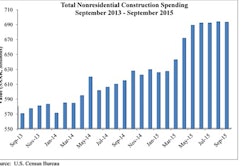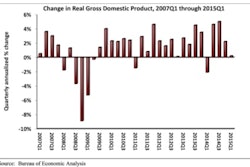
In a sign of continued recovery for the U.S. economy, both real gross domestic product (GDP) and nonresidential fixed investment expanded during the third quarter, according to an Associated Builders and Contractors (ABC) analysis of the release from the Bureau of Economic Analysis. GDP expanded 1.5% (seasonally adjusted annual rate) during the third quarter while nonresidential fixed investment expanded by 2.1% during that period, both building on positive results from the previous quarter.
The bureau estimated that GDP expanded 3.9% during the year's second quarter, while nonresidential fixed investment was revised upward to a 4.1% increase from an initial estimate of a 0.6% decrease. This marks the second consecutive release in which the previous quarter's nonresidential fixed investment figure was amended from negative to positive. Investment in nonresidential structures fell by 4% after growing by 6.2% in the second quarter.
"The U.S. economy is not quite as bad as the headline GDP number suggests," said ABC Chief Economist Anirban Basu. "Private final demand, an indicator that represents sales to nongovernmental domestic purchasers, expanded by 3.2% in the third quarter. Many economists consider this the most telling and persistent aspect of GDP, suggesting that the economy is healthier than some might suspect.
"The current quarter was heavily impacted by a foreseeable inventory adjustment, a stronger dollar and a weakening global economy," said Basu. "The fact that the recovery remains in place is reflected in fixed investment data, including the categories that relate most directly to nonresidential construction. While it is true that investment in structures slipped 4%, this largely appears to be a statistical give-back from the second quarter's better than 6% performance. Other data indicates ongoing momentum in nonresidential construction, which should be more apparent during ensuing GDP releases.
"The recovery will continue to be led by consumers," said Basu. "Interest rates will also feature prominently in terms of determining the extent to which the recovery will be sustained in 2016 and beyond. For now, ultra-low interest rates are inducing people to invest in order to generate financial yields. This has been a bonus for nonresidential construction, but potentially may be triggering over investment in certain construction segments."
Performance of key segments during the third quarter:
- Personal consumption expenditures added 2.19% to GDP after contributing 2.42% in the second quarter.
- Spending on goods grew 4.5% from the second quarter.
- Real final sales of domestically produced output increased 2.9% for the third quarter after a 3.7% increase in the second quarter.
- Federal government spending increased 0.2% in the third quarter after remaining unchanged in the second quarter.
- Nondefense spending increased 2.8% after decreasing by 0.5% in the previous quarter.
- National defense spending fell 1.4% after inching 0.3% higher in the second quarter.
- National defense spending fell 1.5% after growing 1% in the first quarter.
- State and local government spending expanded 2.6% during the third quarter after an increase of 4.3% in the second.
View the Q2 2015 GDP report.


















